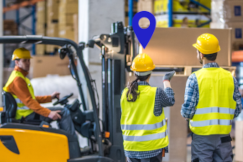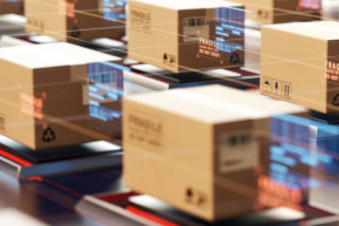Introduction
The need to trace goods and people in working contexts (factories, warehouses, offices, hospitals) is growing exponentially,
and therefore the adoption of Smart Tracking technologies such as, for example,
RTLS (Real-Time Locating Systems), is increasingly common.
These solutions, in addition to the mere tracking of goods and people, are a valuable source of data collection of various types. The aggregation of all this
data can lead to process optimization, to monitoring the micro-climate of an environment, to the creation of an automatic inventory of goods, and to an increase in personnel safety.
However, implementing these technologies is not always a simple operation. One of the major obstacles to implementing real-time localization systems
are infrastructure costs: antennas, cabling, design and installation. The possibility of using existing infrastructures, such as lighting, which
is always present in indoor environments, would make possible to reduce most of the costs and speed up the process of adopting RTLS solutions in
working environments.
The control devices, such as sensors and command keyboards, and the light points themselves can in fact become antennas capable of detecting
the presence and estimate the position of BLE tags that are applied to assets or worn by people.
In this way, the lighting control infrastructure also becomes a localization infrastructure, at no additional cost.
RTLS: what are real-time localization systems and what are their advantages?
The acronym RTLS refers to a Real-Time Location System, i.e. a hardware/software infrastructure based on IoT (Internet of Things) technologies that allows to identify, locate and trace individual objects or people present in a given context (such as, for example, in a logistics site, a factory or a hospital). An RTLS is not limited to just acquiring location data; thanks to sensors installed on the devices, it can also detect data from different nature, for example, the state of what is tracked (movement, alarm events, ...) or environmental parameters (temperature, humidity, ...). The acquisition of this large amount of data in real time makes possible to obtain all the information necessary to create a Digital Twin, i.e. a virtual representation of a specific physical environment.
In the case of Digital Twins based on RTLS, starting from the position, movement and status data of assets or people, it is possible to improve a series of processes: reduce movement times, optimize routes, increase worker safety, acquire visibility on internal processes, increase operational efficiency, increase punctuality and the level of transparency of services provided to customers. RTLS solutions find application in various fields, such as Industry 4.0, logistics, healthcare, smart buildings.
Smart Lighting: what is meant by intelligent lighting and what are its benefits?
Smart Lighting refers to intelligent lighting systems that use advanced technologies,
such as the connectivity of the Internet of Things, to offer greater control and functionality compared to traditional lighting systems.
The benefits of adopting Smart Lighting technologies are numerous:
1. Increased Energy Efficiency: intelligent lighting systems can optimize the use of electricity by automatically adjusting light intensity
based on environmental conditions and user preferences. For example, they can adapt to available natural light and automatically turn off when not needed.
2. Personalisation: thanks to IoT connectivity, it is possible to control intelligent lighting systems via smartphone, tablet or voice assistant.
This allows users to adjust the light intensity, color and even the lighting pattern to create the desired mood at any given moment. For example, you can set
lighting scenarios for different activities, such as work, relaxation or entertainment.
3. Automation and scheduling: smart lighting systems can be programmed to turn on or off automatically based on the time, daily routines, or
motion sensors. This can improve safety, comfort, and increase energy savings.
4. Remote monitoring and management: with intelligent lighting systems, you can monitor and manage your lighting remotely. This is useful for
controlling lights when you are away from home or for monitoring energy consumption. Furthermore, it is possible to receive notifications of maintenance or
anomalies in the functioning of the system.
In general, intelligent lighting systems offer more efficient, customizable and comfortable lighting, while reducing energy consumption and associated costs.
A winning combination!
As anticipated, the possibility of using existing infrastructures, such as those of lighting, to develop RTLS architectures,
would make possible to reduce most of the costs and accelerate the process of adopting RTLS solutions in working environments.
A lighting control infrastructure can, therefore, also become a localization infrastructure, at no additional cost.
Considering that already in the adoption of the individual technologies "RTLS" and "Smart Lighting" numerous advantages can be reaped,
think of how many benefits could be reaped uniting them and making them "collaborate"!
Below we provide some examples of the benefits that could derive from the union of the two technologies:
1. Energy management optimization: the integration of RTLS with the intelligent lighting system allows to further optimize energy
efficiency. Using real-time location data provided by RTLS, the lighting system can turn the lights off or on according to the presence or
absence of people in a given
area. For example, if no people are detected in a room, the lights can automatically turn off to save energy.
2. Increased security: the joint use of Smart Lighting and RTLS can improve security in environments such as corporate buildings or healthcare
facilities. The lighting system can be integrated with the RTLS system to provide a heat map or light guide to indicate the safest escape routes if an emergency arises.
In addition, it can help monitor and prevent intrusion or unauthorized access to certain areas.
3. Space optimization: with the help of RTLS, you can monitor the space usage in real time. This information can be used to adapt the lighting
according to occupied or unoccupied areas, allowing efficient use of electricity. For example, lights can be turned off or dimmed in unoccupied areas, helping to
reduce operating costs.
4. Data analysis: the integration of RTLS with Smart Lighting systems allows you to collect detailed data on the use of areas and lighting
devices. This data can be analyzed to identify usage patterns, trends and anomalies. The information gathered can help you make informed decisions about
resource planning, lighting optimization and energy efficiency.
5. User experience optimization: the combination of Smart Lighting and RTLS can improve the user experience in various contexts.
For example, in a retail environment, the system can use RTLS to sense a customer's location and adapt the lighting to create a pleasant atmosphere
or to direct attention to specific products or areas.
6. Integration with other systems: RTLS and lighting can be integrated with other systems, such as building management systems or
IoT platforms. This allows you to create an ecosystem of interconnected solutions that can further improve the automation, management and overall
efficiency of environments.
It is evident how the union of Smart Lighting and RTLS offers a series of very relevant advantages in various contexts, such as the industrial, commercial or residential environment including, as seen above, greater energy efficiency, better safety, optimized use space and a better user experience.
Success stories: the effectiveness of the union between intelligent lighting and real-time localization
There are already some application cases where the combination of Smart Lighting and RTLS has been successfully implemented. We describe some of them below:
1. Hospitals and healthcare facilities: in many hospitals, the integration of Smart Lighting with RTLS has been used to improve operational
efficiency and patient safety. For example, smart lighting systems are linked to patient and medical staff location tags. This allows to monitor the
position of staff and patients in real time and adjust the lighting as needed. In addition, the system can help locate medical equipment quickly, reducing
search time and improving resource management.
2. Corporate workspaces: many companies have already implemented the combination of Smart Lighting and RTLS to optimize workspace utilization
and improve energy efficiency. Using RTLS, the lighting system can detect the presence or absence of people in certain areas and adjust the lighting accordingly.
This can reduce energy consumption and associated costs. Additionally, the system can provide a real-time heat map of space utilization, enabling companies to
optimize resource planning and workplace design.
3. Retail and point of sale: in the retail space, the combination of smart lighting and RTLS can improve customer experience and operational
efficiency. Intelligent lighting systems can adapt lighting based on the location of customers, guiding them to specific products or creating welcoming atmospheres
in different areas of the store. Furthermore, RTLS can be used to monitor customer traffic trends and optimize product placement and promotion planning.
A bright future: energy savings, security and a better user experience
With the integrated smart lighting and RTLS solutions it will be possible to significantly reduce energy costs, optimizing lighting
in real time based on the presence of people in the different areas, obtaining savings of up to 30% on energy costs, adapting the lighting only when and where
necessary.
All these advantages will be accompanied by a better user experience: in hospitals, for example, patients will be able to enjoy a more comfortable
and reassuring environment, thanks to intelligent lighting that adapts to their needs and promotes their well-being and in the retail sector, the lighting in the
store could vary according to the customers' movements and adapt to their interests and tastes.
Even more important points are safety and risk management, especially in
business and industry. The combined solutions of Smart Lighting and RTLS will improve the safety of operators, improving the lighting system of the buildings,
providing, for example, a light guide for the evacuation routes in case of emergency and detecting unauthorized accesses in real time. Furthermore, it will be
possible to constantly monitor safety of the structures, receiving immediate notifications in the event of anomalous situations or suspicious behavior.
In conclusion, with the adoption of these solutions, it will be possible to optimize the use of spaces, adapting the lighting in real time to the occupied
areas and thus reducing energy waste in unused areas. You will also be able to obtain a detailed view of the use of spaces, which will allow you to improve
resource planning, optimize layouts and reduce operating costs. Ultimately it should be taken into consideration that these two systems will provide valuable
data on the use of spaces, allowing to make informed decisions to improve operational efficiency and optimize resources.
Do you want to find out if BlueUp solutions can help you in your reality? Contact us to know more! 😊
Related content




